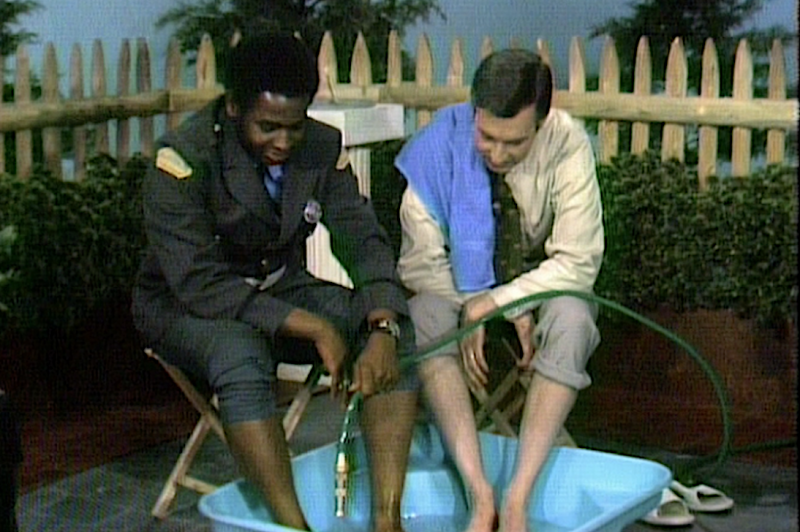Mr. Rogers Shares a Pool

The man pictured to the right, above, hopefully, requires no introduction. That’s Fred Rogers, the host of TV show “Mister Rogers’ Neighborhood,” and if television were to have a patron saint, it’d be him. From 1966 until 2001, children in the United States and around the world learned how to be a good neighbor from Mr. Rogers.
The man on the left, though, you’re probably not familiar with. That’s François Clemmons, an actor and opera singer. Clemmons wasn’t a police officer in real life but played Officer Clemmons, a recurring character on the television show. In the show’s canon, Officer Clemmons was also Mr. Rogers’ neighbor; he ran a singing and dance studio catty-cornered from Mr. Rogers’ house. So as one would expect, every once in awhile, Clemmons would visit his neighbor. There shouldn’t be anything even remotely noteworthy about the picture above, except maybe for how high they rolled up their pants relative to the water level.
For the kids watching, there may not have appeared to be anything out of the ordinary in the image seen above. But for the adults, it was borderline scandalous — or perhaps would have been, had they been watching.
The image above comes from a 1969 broadcast of “Mr. Rogers’ Neighborhood,” which aired just five years after the Civil Rights Act of 1964 ended legal segregation. The vestiges of such discrimination were still present, though, as we all know. Just weeks before the Civil Rights Act went into effect, for example, a motel manager infamously dumped cleaning supplies into a pool, intending to get swimmers — black and white together — to exit the pool. And doing so — throwing toxic chemicals into a pool while people are in there — was probably illegal even before the passage of the Civil Rights Act. Pools, as the New York Times reported many years later, were a flashpoint for the battle over integration:
Pools are supposed to be places to relax, but ever since they exploded in popularity about a century ago, they have served as flash points for racial conflict — vulnerable spaces where prejudices have intensified and violence has often broken out.
“That’s the most intimate thing,” said Greg Carr, chairman of Howard University’s Afro-American studies department. “I’m in this water, you’re in this water, it’s in me, on me.”
This wasn’t lost on Fred Rogers. The scene pictured above makes no direct reference to racism, segregation, or the like; as seen here (via a documentary on Rogers), it’s much simpler than that. It’s a hot day and, to cool off, Mister Rogers decides to put some water on his feet. Officer Clemmons swings by and Rogers invites his neighbor to also put his feet in the pool. At first, Clemmons declines, as he doesn’t have a towel. But Fred Rogers offers to share his, and the two chat for a moment with their feet under a few inches of water.
The seemingly innocuous scene didn’t create an uproar among adults, who probably weren’t watching anyway. And the normalcy of it all — just two neighbors, cooling off on a hot day together — was the point, or at least the one kids watching at home would take away from the moment. As Clemmons notes in the documentary, “[xenophobes] didn’t want black people to come and swim in their swimming pools. My being on the program was a statement for Fred,” and one they both hoped kids would pick up on.
For Fred Rogers, the moment was one that seemed to stick with him. In 1993 — in what would be Clemmons’ final appearance on “Mister Rogers’ Neighborhood” — the two again shared a moment in the backyard footbath, once again showing that neighbors are neighbors regardless of their differences. And in retrospect, Clemmons saw the scene the same way. In 2016, he told NPR that at first, he was “not convinced that Officer Clemmons could have a positive influence in the neighborhood and in the real-world neighborhood, but I think I was proven wrong.”
Bonus fact: In 1984, Burger King ran an ad parodying Mister Rogers, using a character named “Mister Rodney” to lambast McDonald’s for frying their hamburgers. You can watch it here, but if you don’t recall seeing it on television, thank Fred Rogers for that. Fred Rogers fansite Neighborhood Archive explains:
Taking issue with the parody, Fred Rogers contacted the Senior Vice President of Burger King, Don Dempsey, who agreed to pull the advertisement. “To have someone who looks like me doing a commercial is very confusing for children,” Fred Rogers said at the time.
Mr. Dempsey pulled the commercial without question: “Mister Rogers is one guy you don’t want to mess with, as beloved as he is. So that particular commerical goes on the shelf. Hopefully now we have peace in the neighborhood.”
The ad only ran a couple of dozen times as a result.
From the Archives: How Mr. Rogers Made Friday the 13th Less Scary: Here comes the king.
